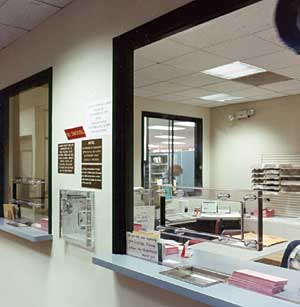Designing Bullet Resistant Protection Panel Systems: Capture More than the Imagination
ACRYLIC
Bullet Resistant Acrylic is available in Levels 1 and 2. It is a cell cast product; it is manufactured in one pour. The light transmission is 93%. It is 43% the weight of aluminum. Super Abrasion Resistant (SAR) has abrasion resistance similar to glass. However, acrylic has many times the breakage resistance of standard tempered glass. If subjected to impact beyond its resistance, Acrylic does not shatter into small potentially injurious slivers as will glass.
 |
| Yolo County Family Court Photo credit: Bullet Guard |
Acrylic, when its edges are polished, is sparkling clear, unlike glass which has a heavy green tint. Because it can be fashioned into a variety of shapes, notched, drilled and fastened, acrylic can give designers unlimited application possibilities. Acrylic comes in two types, abrasion resistant (AR) and Non-AR. AR has a factory-applied coating to the substrate that makes the finish less susceptible to cleaning type scratches. The Non-AR acrylic does not have this second step process. This is a cleaning issue only. If the location is a clean environment, non-AR may be quite suitable and more affordable than AR. Additionally, Non-AR can be periodically rebuffed & most surface scratches removed whereas the AR cannot.
Anti Graffiti Film
Manufacturers have developed a film that makes it easier to deal with graffiti. This film can be applied to Non-AR. Often manufacturers recommend film to be removed and replaced with new film in the field, annually.
Polycarbonate
Polycarbonate is a plastic. It is not bullet resisting unless it is laminated in layers or sheets. It can be laminated with acrylic to achieve bullet resistance.
|
||||||||||||
Polycarbonate has a light tint appearance, is the strongest plastic and captures the buellet instead of deflecting it, making it desireable for lobby situations where customers may be hit by spall.
|
|||||||||||||||||||||||||









